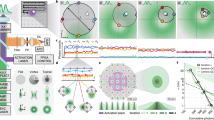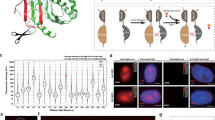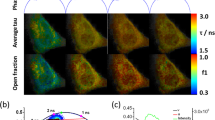Abstract
Imaging single fluorescent proteins in living mammalian cells is challenged by out-of-focus fluorescence excitation. To reduce out-of-focus fluorescence we developed reflected light-sheet microscopy (RLSM), a fluorescence microscopy method allowing selective plane illumination throughout the nuclei of living mammalian cells. A thin light sheet parallel to the imaging plane and close to the sample surface is generated by reflecting an elliptical laser beam incident from the top by 90° with a small mirror. The thin light sheet allows for an increased signal-to-background ratio superior to that in previous illumination schemes and enables imaging of single fluorescent proteins with up to 100-Hz time resolution. We demonstrated the single-molecule sensitivity of RLSM by measuring the DNA-bound fraction of glucocorticoid receptor (GR) and determining the residence times on DNA of various oligomerization states and mutants of GR and estrogen receptor-α (ER), which permitted us to resolve different modes of DNA binding of GR. We demonstrated two-color single-molecule imaging by observing the spatiotemporal colocalization of two different protein pairs. Our single-molecule measurements and statistical analysis revealed dynamic properties of transcription factors.
This is a preview of subscription content, access via your institution
Access options
Subscribe to this journal
Receive 12 print issues and online access
$259.00 per year
only $21.58 per issue
Buy this article
- Purchase on Springer Link
- Instant access to full article PDF
Prices may be subject to local taxes which are calculated during checkout




Similar content being viewed by others
References
Li, G.W. & Xie, X.S. Central dogma at the single-molecule level in living cells. Nature 475, 308–315 (2011).
McNally, J.G., Müller, W.G., Walker, D., Wolford, R. & Hager, G.L. The glucocorticoid receptor: rapid exchange with regulatory sites in living cells. Science 287, 1262–1265 (2000).
Fuda, N.J., Ardehali, M.B. & Lis, J.T. Defining mechanisms that regulate RNA polymerase II transcription in vivo. Nature 461, 186–192 (2009).
Xie, X.S., Choi, P.J., Li, G.W., Lee, N.K. & Lia, G. Single-molecule approach to molecular biology in living bacterial cells. Annu. Rev. Biophys. 37, 417–444 (2008).
Hammar, P. et al. The lac repressor displays facilitated diffusion in living cells. Science 336, 1595–1598 (2012).
Goulian, M. & Simon, S.M. Tracking single proteins within cells. Biophys. J. 79, 2188–2198 (2000).
Seisenberger, G. et al. Real-time single-molecule imaging of the infection pathway of an adeno-associated virus. Science 294, 1929–1932 (2001).
Sako, Y., Minoghchi, S. & Yanagida, T. Single-molecule imaging of EGFR signalling on the surface of living cells. Nat. Cell Biol. 2, 168–172 (2000).
Tokunaga, M., Imamoto, N. & Sakata-Sogawa, K. Highly inclined thin illumination enables clear single-molecule imaging in cells. Nat. Methods 5, 159–161 (2008).
Huisken, J., Swoger, J., Del Bene, F., Wittbrodt, J. & Stelzer, E.H. Optical sectioning deep inside live embryos by selective plane illumination microscopy. Science 305, 1007–1009 (2004).
Friedrich, M. et al. Detection of single quantum dots in model organisms with sheet illumination microscopy. Biochem. Biophys. Res. Commun. 390, 722–727 (2009).
Ritter, J.G., Veith, R., Veenendaal, A., Siebrasse, J.P. & Kubitscheck, U. Light sheet microscopy for single molecule tracking in living tissue. PLoS ONE 5, e11639 (2010).
Cella Zanacchi, F. et al. Live-cell 3D super-resolution imaging in thick biological samples. Nat. Methods 8, 1047–1049 (2011).
Capoulade, J., Wachsmuth, M., Hufnagel, L. & Knop, M. Quantitative fluorescence imaging of protein diffusion and interaction in living cells. Nat. Biotechnol. 29, 835–839 (2011).
Wu, Y. et al. Inverted selective plane illumination microscopy (iSPIM) enables coupled cell identity lineaging and neurodevelopmental imaging in Caenorhabditis elegans. Proc. Natl. Acad. Sci. USA 108, 17708–17713 (2011).
Planchon, T.A. et al. Rapid three-dimensional isotropic imaging of living cells using Bessel beam plane illumination. Nat. Methods 8, 417–423 (2011).
Tsai, S.Y. et al. Molecular interactions of steroid hormone receptor with its enhancer element: evidence for receptor dimer formation. Cell 55, 361–369 (1988).
Aagaard, M.M., Siersbæk, R. & Mandrup, S. Molecular basis for gene-specific transactivation by nuclear receptors. Biochim. Biophys. Acta 1812, 824–835 (2011).
Huisken, J. & Stainier, D.Y. Selective plane illumination microscopy techniques in developmental biology. Development 136, 1963–1975 (2009).
Keppler, A. et al. A general method for the covalent labeling of fusion proteins with small molecules in vivo. Nat. Biotechnol. 21, 86–89 (2003).
Los, G.V. et al. HaloTag: a novel protein labeling technology for cell imaging and protein analysis. ACS Chem. Biol. 3, 373–382 (2008).
Mazza, D., Abernathy, A., Golob, N., Morisaki, T. & McNally, J.G. A benchmark for chromatin binding measurements in live cells. Nucleic Acids Res. 40, e119 (2012).
Manley, S. et al. High-density mapping of single-molecule trajectories with photoactivated localization microscopy. Nat. Methods 5, 155–157 (2008).
English, B.P. et al. Single-molecule investigations of the stringent response machinery in living bacterial cells. Proc. Natl. Acad. Sci. USA 108, E365–E373 (2011).
Speil, J. et al. Activated STAT1 transcription factors conduct distinct saltatory movements in the cell nucleus. Biophys. J. 101, 2592–2600 (2011).
Akhtar, A. & Gasser, S.M. The nuclear envelope and transcriptional control. Nat. Rev. Genet. 8, 507–517 (2007).
Thompson, R.E., Larson, D.R. & Webb, W.W. Precise nanometer localization analysis for individual fluorescent probes. Biophys. J. 82, 2775–2783 (2002).
Bancaud, A. et al. Molecular crowding affects diffusion and binding of nuclear proteins in heterochromatin and reveals the fractal organization of chromatin. EMBO J. 28, 3785–3798 (2009).
Elf, J., Li, G.W. & Xie, X.S. Probing transcription factor dynamics at the single-molecule level in a living cell. Science 316, 1191–1194 (2007).
Becker, M. et al. Dynamic behavior of transcription factors on a natural promoter in living cells. EMBO Rep. 3, 1188–1194 (2002).
Heck, S. et al. IκBαa-independent downregulation of NF-κB activity by glucocorticoid receptor. EMBO J. 16, 4698–4707 (1997).
Zava, D.T., Chamness, G.C., Horwitz, K.B. & McGuire, W.L. Human breast cancer: biologically active estrogen receptor in the absence of estrogen? Science 196, 663–664 (1977).
Hong, H., Kohli, K., Trivedi, A., Johnson, D.L. & Stallcup, M.R. GRIP1, a novel mouse protein that serves as a transcriptional coactivator in yeast for the hormone binding domains of steroid receptors. Proc. Natl. Acad. Sci. USA 93, 4948–4952 (1996).
Beck, M. et al. The quantitative proteome of a human cell line. Mol. Syst. Biol. 7, 549 (2011).
Gekakis, N. et al. Role of the CLOCK protein in the mammalian circadian mechanism. Science 280, 1564–1569 (1998).
Sprague, B.L. et al. Analysis of binding at a single spatially localized cluster of binding sites by fluorescence recovery after photobleaching. Biophys. J. 91, 1169–1191 (2006).
Beaudouin, J., Mora-Bermúdez, F., Klee, T., Daigle, N. & Ellenberg, J. Dissecting the contribution of diffusion and interactions to the mobility of nuclear proteins. Biophys. J. 90, 1878–1894 (2006).
Mueller, F., Mazza, D., Stasevich, T.J. & McNally, J.G. FRAP and kinetic modeling in the analysis of nuclear protein dynamics: what do we really know? Curr. Opin. Cell Biol. 22, 403–411 (2010).
Stavreva, D.A., Varticovski, L. & Hager, G.L. Complex dynamics of transcription regulation. Biochim. Biophys. Acta 1819, 657–666 (2012).
Mueller, F., Morisaki, T., Mazza, D. & McNally, J.G. Minimizing the impact of photoswitching of fluorescent proteins on FRAP analysis. Biophys. J. 102, 1656–1665 (2012).
McKinney, S.A., Murphy, C.S., Hazelwood, K.L., Davidson, M.W. & Looger, L.L. A bright and photostable photoconvertible fluorescent protein. Nat. Methods 6, 131–133 (2009).
Nguyen, A.W. & Daugherty, P.S. Evolutionary optimization of fluorescent proteins for intracellular FRET. Nat. Biotechnol. 23, 355–360 (2005).
Shaner, N.C. et al. Improving the photostability of bright monomeric orange and red fluorescent proteins. Nat. Methods 5, 545–551 (2008).
Jones, S.A., Shim, S.H., He, J. & Zhuang, X. Fast, three-dimensional super-resolution imaging of live cells. Nat. Methods 8, 499–508 (2011).
Moerner, W.E. & Fromm, D.P. Methods of single-molecule fluorescence spectroscopy and microscopy. Rev. Sci. Instrum. 74, 3597 (2003).
Schütz, G.J., Schindler, H. & Schmidt, T. Single-molecule microscopy on model membranes reveals anomalous diffusion. Biophys. J. 73, 1073–1080 (1997).
Gebhardt, J.C.M., Clemen, A.E., Jaud, J. & Rief, M. Myosin-V is a mechanical ratchet. Proc. Natl. Acad. Sci. USA 103, 8680–8685 (2006).
Acknowledgements
We acknowledge W. Min for his contribution in the early stage of this work. The pLV-tetO-Oct4 plasmid was provided by K. Hochedlinger (Howard Hughes Medical Institute and Harvard Stem Cell Institute), and MD2G and PAX2 plasmids were provided by D. Trono (Ecole Polytechnique Fédérale de Lausanne). We acknowledge funding from the US National Institutes of Health (X.S.X. (5RO1EB010244-3 and 5R01GM096450-02) and T.M. (R01NS043915 and DP1OD003930-03)), Human Frontier Science Program (J.C.M.G.), fellowship for advanced researchers from the Swiss National Science Foundation (D.M.S.), Jane Coffin Childs postdoctoral fellowship (R.R.), National Science Scholarship from the Agency of Science, Technology and Research (A*STAR) of Singapore (Z.W.Z.) and Molecular Biophysics Training Grant Agency, US National Institutes of Health–National Institute of General Medical Sciences T32 GM008313 (A.R.C.). This work was performed in part at the Harvard Center for Nanoscale Systems, a member of the National Nanotechnology Infrastructure Network, which is supported by the US National Science Foundation under award ECS-0335765.
Author information
Authors and Affiliations
Contributions
J.C.M.G. conceived and set up the reflected light-sheet microscope. J.C.M.G. and D.M.S. designed experiments. J.C.M.G. performed measurements and analyzed data. D.M.S. cloned fusion proteins, established cell lines and contributed to measurements and data analysis. J.C.M.G. and R.R. cloned mEos2-GR and mEos2-H4. R.R., Z.W.Z. and A.R.C. contributed to system setup. R.R. and Z.W.Z. contributed to light sheet characterization. R.R. and A.R.C. contributed to the analysis code. S.B. contributed to cloning. R.R., Z.W.Z. and S.B. contributed cells for initial performance tests. X.S.X. initiated the project. X.S.X. and T.M. supervised the project. J.C.M.G., D.M.S., T.M. and X.S.X. wrote the manuscript with contributions from all authors.
Corresponding author
Ethics declarations
Competing interests
The authors declare no competing financial interests.
Supplementary information
Supplementary Text and Figures
Supplementary Figures 1–10 and Supplementary Tables 1 and 2 (PDF 12902 kb)
Animation of the RLSM setup
The vertical arrangement of illumination and detection objectives combined with a small mirror next to the cell enables selective plane illumination of the cell nucleus with a thin sheet of light. z sectioning is achieved by piezo-driven movement of the sample. Common glass bottom cell culture dishes can be used to grow and image the cells. (MOV 2828 kb)
SNAP-tag control
SNAP protein, labeled with TMR, expressed in an MCF-7 cell and imaged by RLSM. TMR was excited with a 560-nm laser. The video shows 200 frames taken at 33 Hz. (MOV 8845 kb)
Halo-tag control
Halo protein, labeled with TMR, expressed in a U2-OS cell and imaged by RLSM. TMR was excited with a 560-nm laser. The video shows 200 frames taken at 33 Hz. (MOV 8535 kb)
mEos2 control
mEos2 fluorescent protein, expressed in a MCF-7 cell and imaged by RLSM. mEos2 was activated with a 405-nm laser, and excited with a 560-nm laser. The video shows 200 frames taken at 28 Hz. (MOV 7271 kb)
YPet control
YPet fluorescent protein, expressed in a U2-OS cell and imaged by RLSM. YPet was excited with a 514-nm laser. The video shows 200 frames taken at 20 Hz. (MOV 8229 kb)
Diffusion of mEos2-GCR
Glucocorticoid receptor fused to mEos2, expressed in an MCF-7 cell in the presence of 100 nM dexamethasone and imaged by RLSM. mEos2 was activated with a 405-nm laser and excited with a 560-nm laser. The video shows 200 frames taken at 100 Hz. (MOV 8518 kb)
Residence-time measurement of YPet-GCR
Glucocorticoid receptor fused to YPet, expressed in an MCF-7 cell in the presence of 100 nM dexamethasone and imaged by RLSM. YPet was excited with a 514-nm laser. The video shows 200 frames taken at 20 Hz. (MOV 4610 kb)
Colocalization of GCR and GRIP1
GRIP1 fused to EGFP and GCR fused to TagRFP-T, expressed in a U2-OS cell in the presence of 100 nM dexamethasone and imaged by RLSM. Excitation alternated every 50 ms between a 488-nm laser and a 560-nm laser. For better representation, successive EGFP (false-color green) and TagRFP-T (false-color red) images were overlaid. The red arrowhead highlights a GCR-GRIP1 colocalization event; the blue arrowhead highlights a GRIP1 binding event. The video shows 100 frames (50 overlaid frames) at 20 Hz. (MOV 2224 kb)
Colocalization of BMAL1 and CLOCK
CLOCK fused to EGFP and BMAL1 fused to TagRFP-T, expressed in a U2-OS cell and imaged by RLSM 24 h after serum shock. Excitation alternates every 50 ms between a 488-nm laser and a 560-nm laser. For better representation, successive EGFP (false-color green) and TagRFP-T (false-color red) images were overlaid. The red arrowhead highlights a BMAL1-CLOCK colocalization event; the blue arrowhead highlights a CLOCK binding event. The video shows 100 frames (50 overlaid frames) at 20 Hz. (MOV 3025 kb)
Rights and permissions
About this article
Cite this article
Gebhardt, J., Suter, D., Roy, R. et al. Single-molecule imaging of transcription factor binding to DNA in live mammalian cells. Nat Methods 10, 421–426 (2013). https://doi.org/10.1038/nmeth.2411
Received:
Accepted:
Published:
Issue Date:
DOI: https://doi.org/10.1038/nmeth.2411
This article is cited by
-
Chromatin organization drives the search mechanism of nuclear factors
Nature Communications (2023)
-
OptoRheo: Simultaneous in situ micro-mechanical sensing and imaging of live 3D biological systems
Communications Biology (2023)
-
Single molecule microscopy to profile the effect of zinc status on transcription factor dynamics
Scientific Reports (2022)
-
Resolution doubling in light-sheet microscopy via oblique plane structured illumination
Nature Methods (2022)
-
Stress induced TDP-43 mobility loss independent of stress granules
Nature Communications (2022)



